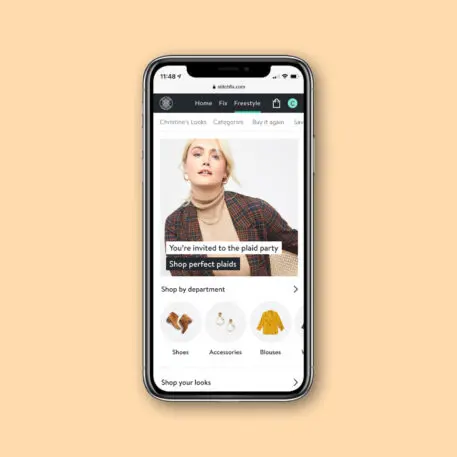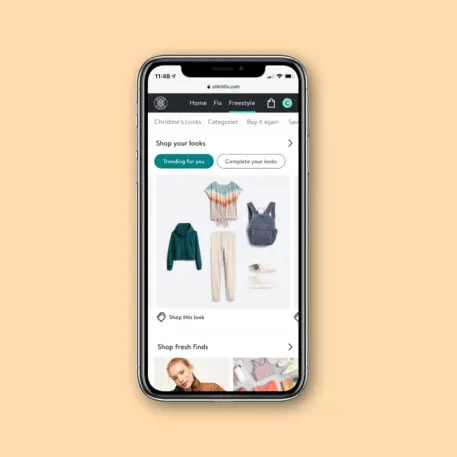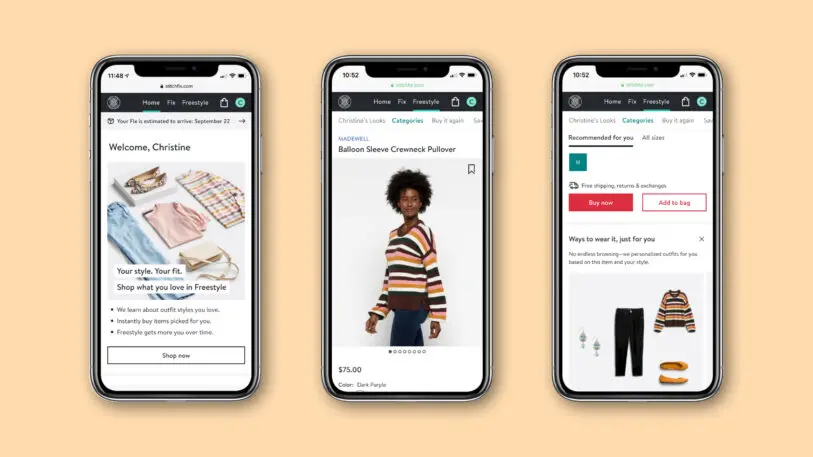Shopping for fashion online hasn’t changed much over the past two decades. But Stitch Fix thinks it should.
Katrina Lake founded Stitch Fix in 2011 as a styling service that used a combination of data and human stylists to send customers boxes of personalized products from dozens of brands, including Madewell, Kate Spade, Champion, and The North Face. Over the past decade, it has grown into a fashion behemoth, with 4.1 million active users generating $1.7 billion in revenue in 2020. Now, the company has a bold new ambition: It wants to use its data to transform the online shopping experience.
Today, the company launches a new platform called Freestyle that creates a customized store for every shopper. It’s designed to mimic the discovery process of a traditional department store, where brands and styles are showcased together, rather than a typical e-commerce site, where you have to search for exactly what you want. This new approach to shopping has the potential to grow Stitch Fix’s business beyond its subscription model—and also transform the way we shop online.

A digital department store
Online shopping is great if you know exactly what you’re looking for, but it’s never been very good at helping consumers discover the unexpected. “E-commerce democratized shopping, allowing you to do it from the comfort of your own home,” says Elizabeth Spaulding, who became Stitch Fix’s CEO in August, taking over from Lake. “But it’s inconvenient in so many ways: You’re forced to search and scroll for products, and the vast majority of what you’re seeing is not relevant to you. We wanted to create a shopping experience based on discovery.”
With Freestyle, Stitch Fix is attempting to recreate the way we shop in physical department stores or boutiques, but in a digital form. In a brick-and-mortar shop, stylists put together looks on mannequins or in shop windows, pulling pieces from different brands. As a customer, you might fall in love with an entire outfit and buy it on the spot, or the look might inspire you to explore similar pieces.

[Image: Stitch Fix]This entire experience is powered by the data Stitch Fix has collected over the past 10 years of curating boxes of clothes for clients. If you’re already a Stitch Fix subscriber, the company will use the data it has accrued about you to curate your Freestyle shop. But for people like me, who haven’t shopped with Stitch Fix before, the algorithm starts by using data from customers who are demographically similar to populate my feed; over time, the algorithm will get smarter and further customize my results. Spaulding says the company also has data about how each garment fits and will only suggest items that the algorithm believes will look good on a particular customer’s body type. “We definitely have more data for somebody who’s been with us for a long period of time,” says Spaulding. “But we can actually do quite a lot by leveraging the limited data points we have from you as an individual, because we can map you to people who are like you within our customer base.”

Transforming e-commerce
Until now, Stitch Fix has focused primarily on consumers who don’t want to shop and would rather receive a box of clothes tailored to their preferences. (Subscribers can order boxes as frequently as they like, and pay a $20 styling fee that goes toward anything they purchase.) During the pandemic, business boomed: Stitch Fix’s 2020 revenue increased 20% from the year before, hitting $1.7 billion. Stitch Fix will continue to offer these curated boxes, but Spaulding believes Freestyle will capture a different type of customer, one that enjoys browsing. “There are some customers who don’t want to think about anything when it comes to shopping,” says Spaulding. “But you’ve got people at the other end of the spectrum who we haven’t served as well. They love to participate in the shopping experience, and we believe this is going to be so much better for them than what is already out there.”

Spaulding believes that Freestyle will allow Stitch Fix to compete with other major retailers. Department stores have been in decline over the past decade, with monthly revenue dropping from $15.6 billion in 2010 to $6.2 billion in 2020. And during the pandemic, many of these stores went bankrupt, including Neiman Marcus and JC Penney. Spaulding says the company now has the opportunity to swoop in and win over some of their customers. “Retail as a whole shrunk in the last year, while we grew,” she says. “We really believe that this will be the future of retail.”
Recognize your brand’s excellence by applying to this year’s Brands That Matter Awards before the early-rate deadline, May 3.